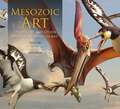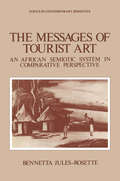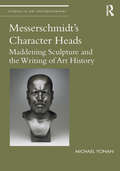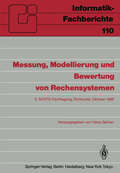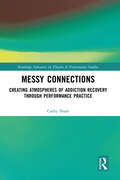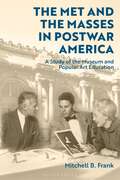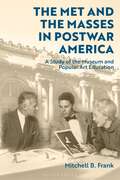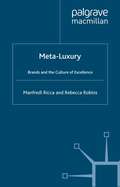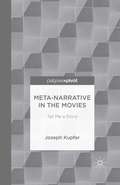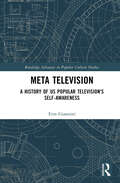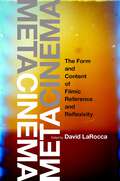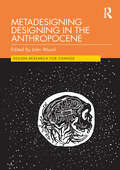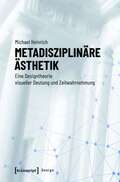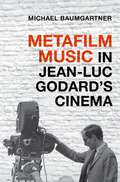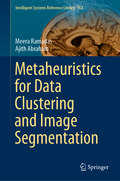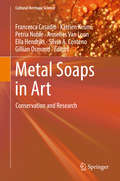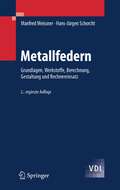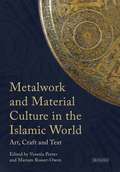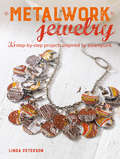- Table View
- List View
Mesozoic Art: Dinosaurs and Other Ancient Animals in Art
by Steve White Darren NaishShowcases the work of twenty leading paleoartists who expertly bring these extinct animals to life in exquisite detail.Dinosaurs are endlessly fascinating to people of every age, from the youngest child who enjoys learning the tongue-twisting names to adults who grew up with Jurassic Park and Walking with Dinosaurs. As our knowledge of the prehistoric world continues to evolve and grow, so has the discipline of bringing these ancient worlds to life artistically. Paleoart puts flesh on the bones of long-extinct organisms, and illustrates the world they lived in. Mesozoic Art presents twenty of the best artists working in this field, representing a broad spectrum of disciplines, from traditional painting to cutting-edge digital technology. Some provide the artwork for new scientific papers that demand high-end paleoart as part of their presentation to the world at large; they also work for the likes of National Geographic and provide art to museums around the world to illustrate their displays. Other artists are the new rising stars of paleoart in an ever-growing, ever-diversifying field. Arranged by portfolio, this book brings this dramatic art to a wide, contemporary audience. The art is accompanied by text on the animals and their lives, written by palaeontologist Darren Naish. Paleoart is dynamic, fluid and colourful, as were the beasts it portrays, which are displayed in this magnificent book.
The Messages of Tourist Art: An African Semiotic System in Comparative Perspective (Topics in Contemporary Semiotics #4)
by Bennetta Jules-RosetteTourist art may be a billion dollar business. Nevertheless, such art is despised. What is worse, the "bad" culture is seen as driving out the "good. " Commer cialization is assumed to destroy traditional arts and crafts, replacing them with junk. The process is seen as demeaning to artists in the traditional societies, who are seduced into a type of whoredom: unfeeling production of false beauty for money. The arts remain problematic for the social sciences. Sociology textbooks treat the arts as subordinate reflections of social forces, norms, or groups. An thropology textbooks conventionally isolate the arts in a separate chapter, failing to integrate them with analyses of kinship, economics, politics, language, or biology. Textbooks reflect the guiding theories, which emphasize such factors as modes of production, patterns of thought, or biological and normative con straints, but their authors have not adequately formulated the aesthetic dimen sion. One may compare the theoretical status of the arts to that of religion. After the contributions by Emile Durkheim and Max Weber, the sociology of religion is well established, but where is a Durkheim or Weber for the sociology of art? What is true of the social sciences in general holds for understanding of modernization in the Third World. These processes and those places are analyzed economically, politically, and socially, but the aesthetic dimension is treated in isolation, if at all, and is poorly grasped in relation to the other forces.
Messerschmidt's Character Heads: Maddening Sculpture and the Writing of Art History (Studies in Art Historiography)
by Michael YonanThis book examines a famous series of sculptures by the German artist Franz Xaver Messerschmidt (1736–1783) known as his "Character Heads." These are busts of human heads, highly unconventional for their time, representing strange, often inexplicable facial expressions. Scholars have struggled to explain these works of art. Some have said that Messerschmidt was insane, while others suggested that he tried to illustrate some sort of intellectual system. Michael Yonan argues that these sculptures are simultaneously explorations of art’s power and also critiques of the aesthetic limits that would be placed on that power.
Messerschmidt's Character Heads: Maddening Sculpture and the Writing of Art History (Studies in Art Historiography)
by Michael YonanThis book examines a famous series of sculptures by the German artist Franz Xaver Messerschmidt (1736–1783) known as his "Character Heads." These are busts of human heads, highly unconventional for their time, representing strange, often inexplicable facial expressions. Scholars have struggled to explain these works of art. Some have said that Messerschmidt was insane, while others suggested that he tried to illustrate some sort of intellectual system. Michael Yonan argues that these sculptures are simultaneously explorations of art’s power and also critiques of the aesthetic limits that would be placed on that power.
Messung, Modellierung und Bewertung von Rechensystemen: 3. GI/NTG-Fachtagung Dortmund, 1.–3. Oktober 1985 (Informatik-Fachberichte #110)
by Heinz BeilnerMessy Connections: Creating Atmospheres of Addiction Recovery Through Performance Practice (ISSN)
by Cathy SloanThis book examines performance practices that involve people in recovery from addiction, theorising such practices as recovery-engaged.Focusing on examples of practice from a growing movement of UK-based recovery arts practitioners and performers, it highlights a unique approach to performance that infuses an understanding of lived experiences of addiction and recovery with creative practice. It offers a philosophy of being in recovery that understands lived experience, and performance practice, as a dynamic system of interrelations with the human and nonhuman elements that make up the societal settings in which recovery communities struggle to exist. It thereby frames the process of recovery, and recovery-engaged performance, as an affective ecology – a system of messy connections. Building upon ideas from posthumanist research on addiction, cultural theory on identity and new materialist interpretations of performance practice, it considers how such contemporary theory might offer additional ways of thinking and doing arts practice with people affected by addiction. The discussion highlights the distinct aesthetics, ethics and politics of this area of performance practice.This study will be of great interest to students and scholars in Applied Theatre and Critical Arts and Mental Health studies.
Messy Connections: Creating Atmospheres of Addiction Recovery Through Performance Practice (ISSN)
by Cathy SloanThis book examines performance practices that involve people in recovery from addiction, theorising such practices as recovery-engaged.Focusing on examples of practice from a growing movement of UK-based recovery arts practitioners and performers, it highlights a unique approach to performance that infuses an understanding of lived experiences of addiction and recovery with creative practice. It offers a philosophy of being in recovery that understands lived experience, and performance practice, as a dynamic system of interrelations with the human and nonhuman elements that make up the societal settings in which recovery communities struggle to exist. It thereby frames the process of recovery, and recovery-engaged performance, as an affective ecology – a system of messy connections. Building upon ideas from posthumanist research on addiction, cultural theory on identity and new materialist interpretations of performance practice, it considers how such contemporary theory might offer additional ways of thinking and doing arts practice with people affected by addiction. The discussion highlights the distinct aesthetics, ethics and politics of this area of performance practice.This study will be of great interest to students and scholars in Applied Theatre and Critical Arts and Mental Health studies.
The Met and the Masses in Postwar America: A Study of the Museum and Popular Art Education
by Mitchell FrankThis book explores the collaborations, during the mid-20th century, between the Metropolitan Museum of Art and the Book-of-the-Month Club. Between 1948 and 1962 the two institutions collaborated on three book projects-The Metropolitan Museum of Art Miniatures (1948-1957), The Metropolitan Seminars in Art (1958-60), and a print reproduction of Rembrandt's Aristotle Contemplating the Bust of Homer (1962)-bringing art from the Met's collections right into the homes of subscribers.The Met and the Masses places these commercial enterprises in a variety of contemporary and historical contexts, including the relation of cultural education to democracy in America, the history of the Met as an educational institution, the rise of art education in postwar America, and the concurrent transformation of the home into a space that mediated familial privacy and the public sphere.Using never before published archival material, the book demonstrates how the Met sought to bring art to the masses in postwar America, whilst upholding its reputation as an institution of high culture. It is essential reading for scholars, researchers and curators interested in the history of modern art, museum and curatorial studies, arts and cultural management, heritage studies, as well as the history of art publications.
The Met and the Masses in Postwar America: A Study of the Museum and Popular Art Education
by Mitchell FrankThis book explores the collaborations, during the mid-20th century, between the Metropolitan Museum of Art and the Book-of-the-Month Club. Between 1948 and 1962 the two institutions collaborated on three book projects-The Metropolitan Museum of Art Miniatures (1948-1957), The Metropolitan Seminars in Art (1958-60), and a print reproduction of Rembrandt's Aristotle Contemplating the Bust of Homer (1962)-bringing art from the Met's collections right into the homes of subscribers.The Met and the Masses places these commercial enterprises in a variety of contemporary and historical contexts, including the relation of cultural education to democracy in America, the history of the Met as an educational institution, the rise of art education in postwar America, and the concurrent transformation of the home into a space that mediated familial privacy and the public sphere.Using never before published archival material, the book demonstrates how the Met sought to bring art to the masses in postwar America, whilst upholding its reputation as an institution of high culture. It is essential reading for scholars, researchers and curators interested in the history of modern art, museum and curatorial studies, arts and cultural management, heritage studies, as well as the history of art publications.
Meta-Luxury: Brands and the Culture of Excellence
by M. Ricca R. RobinsMeta-Luxury sets out to define the ultimate meaning of true luxury, exploring it as both a culture and business model. Through the concept of Unique Achievement and the drivers of Craftsmanship, Focus, History and Rarity, the authors examine what is at the heart of true luxury through a unique series of conversations.
Meta-Narrative in the Movies: Tell Me a Story
by J. KupferMeta-Narrative in the Movies investigates narrative theory through close analysis of films featuring stories and storytelling. The cinematic interpretations investigate the role of story creation in knowing ourselves and planning our future, in structuring social relationships, and in sharpening our experience of popular culture.
Meta Television: A History of US Popular Television's Self-Awareness (Routledge Advances in Popular Culture Studies)
by Erin GianniniThe idea of metatextuality is frequently framed as a recent television development and often paired with the idea that it represents genre exhaustion. US television, however, with its early “live” performances and set-bound sitcoms, always suggested an element of self-awareness that easily shaded into metatextuality even in its earliest days. Meta Television thus traces the general history of US television’s metatextuality throughout television’s history, arguing that TV’s self-awareness is nothing new—and certainly not evidence of a period of aesthetic exhaustion—but instead is woven into both its past and present practice, elucidated through case studies featuring series from the 1970s to the present day—many of which have not been critically analyzed before—and the various ways they deploy metatext to both construct and deconstruct their narratives. Further, Meta Television asserts that this re- and de-construction of narrative and production isn’t just a reward to the savvy and/or knowledgeable viewer (or consumer), but seeks to make broader points about the media we consume—and how we consume it.This book explores the ways in which the current metatextual turn, in both the usual genres in which it appears (horror and sci-fi/fantasy) and its movement into drama and sitcom, represents the next turn in television’s inherent self-awareness. It traces this element throughout television’s history, growing from the more modest reflexivity of programs’ awareness of themselves, as created objects in a particular medium, to the more significant breaking of the fictive illusion and therefore the perceived distance between the audience and the series. Erin Giannini shows how the increased currency of metatextual television in the contemporary era can be tied to a viewership well-versed in its stories and production as well as able and willing to “talk back” via social media. If television reflects culture to a certain extent, this increased reflexivity mirrors that “responsive” audience as a consequence of the lack of distance that metafiction embraces.As Robert Stam traced the use—and implications—of reflexivity in film and literature, this book does the same for television, further problematizing John Ellis’s glance theory in terms of both production and spectatorship.
Meta Television: A History of US Popular Television's Self-Awareness (Routledge Advances in Popular Culture Studies)
by Erin GianniniThe idea of metatextuality is frequently framed as a recent television development and often paired with the idea that it represents genre exhaustion. US television, however, with its early “live” performances and set-bound sitcoms, always suggested an element of self-awareness that easily shaded into metatextuality even in its earliest days. Meta Television thus traces the general history of US television’s metatextuality throughout television’s history, arguing that TV’s self-awareness is nothing new—and certainly not evidence of a period of aesthetic exhaustion—but instead is woven into both its past and present practice, elucidated through case studies featuring series from the 1970s to the present day—many of which have not been critically analyzed before—and the various ways they deploy metatext to both construct and deconstruct their narratives. Further, Meta Television asserts that this re- and de-construction of narrative and production isn’t just a reward to the savvy and/or knowledgeable viewer (or consumer), but seeks to make broader points about the media we consume—and how we consume it.This book explores the ways in which the current metatextual turn, in both the usual genres in which it appears (horror and sci-fi/fantasy) and its movement into drama and sitcom, represents the next turn in television’s inherent self-awareness. It traces this element throughout television’s history, growing from the more modest reflexivity of programs’ awareness of themselves, as created objects in a particular medium, to the more significant breaking of the fictive illusion and therefore the perceived distance between the audience and the series. Erin Giannini shows how the increased currency of metatextual television in the contemporary era can be tied to a viewership well-versed in its stories and production as well as able and willing to “talk back” via social media. If television reflects culture to a certain extent, this increased reflexivity mirrors that “responsive” audience as a consequence of the lack of distance that metafiction embraces.As Robert Stam traced the use—and implications—of reflexivity in film and literature, this book does the same for television, further problematizing John Ellis’s glance theory in terms of both production and spectatorship.
Metacinema: The Form and Content of Filmic Reference and Reflexivity
by David LaRoccaWhen a work of art shows an interest in its own status as a work of arteither by reference to itself or to other workswe have become accustomed to calling this move "meta." While scholars and critics have, for decades, acknowledged reflexivity in films, it is only in Metacinema, for the first time, that a group of leading and emerging film theorists join to enthusiastically debate the meanings and implications of the meta for cinema. In new essays on generative films, including Rear Window, 8 1/2, Holy Motors, Funny Games, Fight Club, and Clouds of Sils Maria, contributors chart, explore, and advance the ways in which metacinema is at once a mode of filmmaking and a heuristic for studying cinematic attributes. What results is not just an engagement with certain practices and concepts in widespread use in the movies (from Hollywood to global cinema, from documentary to the experimental and avant-garde), but also the development of a veritable and vital new genre of film studies. With more and more films expressing reflexivity, recursion, reference to other films, mise-en-abîme, seriality, and exhibiting related intertextual and intermedial traits, the time is overdue for the kind of capacious yet nuanced critical study found in Metacinema.
Metacinema: The Form and Content of Filmic Reference and Reflexivity
When a work of art shows an interest in its own status as a work of arteither by reference to itself or to other workswe have become accustomed to calling this move "meta." While scholars and critics have, for decades, acknowledged reflexivity in films, it is only in Metacinema, for the first time, that a group of leading and emerging film theorists join to enthusiastically debate the meanings and implications of the meta for cinema. In new essays on generative films, including Rear Window, 8 1/2, Holy Motors, Funny Games, Fight Club, and Clouds of Sils Maria, contributors chart, explore, and advance the ways in which metacinema is at once a mode of filmmaking and a heuristic for studying cinematic attributes. What results is not just an engagement with certain practices and concepts in widespread use in the movies (from Hollywood to global cinema, from documentary to the experimental and avant-garde), but also the development of a veritable and vital new genre of film studies. With more and more films expressing reflexivity, recursion, reference to other films, mise-en-abîme, seriality, and exhibiting related intertextual and intermedial traits, the time is overdue for the kind of capacious yet nuanced critical study found in Metacinema.
Metadesigning Designing in the Anthropocene (Design Research for Change)
by John WoodLong-sighted, radical and provocative, this book offers a foundational framework of concepts, principles and methods (exemplified with selected tools) to enable metadesigners to manage and reinvent their practices. The book reminds readers that designers are, albeit unwittingly, helping to shape the Anthropocene. Despite their willingness to deliver greener products and services, designers find themselves part of an industry that has become the go-to catalyst for dividends and profit. If our species is to achieve the rehabilitation and metamorphosis, we may need to design at the level of paradigms, genres, lifestyles and currencies. This would mean making design more integrated, comprehensive, adaptive, transdisciplinary, self-reflexive and relational. The book, therefore, advocates a shift of emphasis from designing ‘sustainable’ products, services and systems towards cultivating synergies that will induce regenerative lifestyles. The book will be of interest to managers, designers, scholars and educators from a wide range of backgrounds, including design research, design history, design studies and environmental studies.
Metadesigning Designing in the Anthropocene (Design Research for Change)
by John WoodLong-sighted, radical and provocative, this book offers a foundational framework of concepts, principles and methods (exemplified with selected tools) to enable metadesigners to manage and reinvent their practices. The book reminds readers that designers are, albeit unwittingly, helping to shape the Anthropocene. Despite their willingness to deliver greener products and services, designers find themselves part of an industry that has become the go-to catalyst for dividends and profit. If our species is to achieve the rehabilitation and metamorphosis, we may need to design at the level of paradigms, genres, lifestyles and currencies. This would mean making design more integrated, comprehensive, adaptive, transdisciplinary, self-reflexive and relational. The book, therefore, advocates a shift of emphasis from designing ‘sustainable’ products, services and systems towards cultivating synergies that will induce regenerative lifestyles. The book will be of interest to managers, designers, scholars and educators from a wide range of backgrounds, including design research, design history, design studies and environmental studies.
Metadisziplinäre Ästhetik: Eine Designtheorie visueller Deutung und Zeitwahrnehmung (Design #45)
by Michael HeinrichSinnliche Wahrnehmung und deren Deutung bilden die Grundlage unserer Welterfahrung. Wissenschaftler und Gestalter fragen daher seit der Antike, auf welche Weise ästhetische Empfindungen unser Fühlen, Denken und Handeln prägen. Michael Heinrich führt zunächst wissenschaftliche Perspektiven zur Ästhetik vergleichend zusammen und entwirft übergreifende Denkmodelle. Dabei wird erstmalig der enge Zusammenhang zwischen Ästhetik, Bewusstsein und Zeitwahrnehmung verdeutlicht, an Beispielen erklärt und konzeptionalisiert. Eine Übersicht zu den beachtlichen Auswirkungen ästhetischer Umfeldqualitäten auf Gesundheit und Wohlbefinden verweist schlussendlich auf die Verantwortung und das hohe Potenzial integrativen Designs für menschliche Lebensqualität.
Metafilm Music in Jean-Luc Godard's Cinema (Oxford Music / Media)
by Michael BaumgartnerHailed as a leading innovator of visual montage, unique storytelling style, and ground-breaking cinematography, Jean-Luc Godard is a prominent pioneer in sculpting complex soundtracks altering the familiar relationship between sound and image, but his achievements in sound have been largely overlooked. Such a lacuna in the extensive research on Godard's work is unfortunate, as Godard's lifelong preoccupation of exploring self-reflexively all aspects of filmmaking particularly affects film music. With the novel approach of metafilm music, extrapolated from Jean-Luc Godard's oeuvre, this book not only closes up a crucial gap in Godard research, but also offers detailed analyses of the music as metafilm music in Contempt, Alphaville, Band of Outsiders, Pierrot le fou, First Name: Carmen, Histoire(s) du cinéma, among other films and video productions. The innovative scholarly concept of metafilm music, enriching the burgeoning field of music in audio-visual media, describes how Godard thinks about film music with film music. This book thus provides a thorough examination of Godard's self-reflexive approach to film music which has resulted in a lifelong creation of multi-layered soundtracks pushing the envelope of film music and sound to the limit.
Metafilm Music in Jean-Luc Godard's Cinema (Oxford Music / Media)
by Michael BaumgartnerHailed as a leading innovator of visual montage, unique storytelling style, and ground-breaking cinematography, Jean-Luc Godard is a prominent pioneer in sculpting complex soundtracks altering the familiar relationship between sound and image, but his achievements in sound have been largely overlooked. Such a lacuna in the extensive research on Godard's work is unfortunate, as Godard's lifelong preoccupation of exploring self-reflexively all aspects of filmmaking particularly affects film music. With the novel approach of metafilm music, extrapolated from Jean-Luc Godard's oeuvre, this book not only closes up a crucial gap in Godard research, but also offers detailed analyses of the music as metafilm music in Contempt, Alphaville, Band of Outsiders, Pierrot le fou, First Name: Carmen, Histoire(s) du cinéma, among other films and video productions. The innovative scholarly concept of metafilm music, enriching the burgeoning field of music in audio-visual media, describes how Godard thinks about film music with film music. This book thus provides a thorough examination of Godard's self-reflexive approach to film music which has resulted in a lifelong creation of multi-layered soundtracks pushing the envelope of film music and sound to the limit.
Metaheuristics for Data Clustering and Image Segmentation (Intelligent Systems Reference Library #152)
by Meera Ramadas Ajith AbrahamIn this book, differential evolution and its modified variants are applied to the clustering of data and images. Metaheuristics have emerged as potential algorithms for dealing with complex optimization problems, which are otherwise difficult to solve using traditional methods. In this regard, differential evolution is considered to be a highly promising technique for optimization and is being used to solve various real-time problems. The book studies the algorithms in detail, tests them on a range of test images, and carefully analyzes their performance. Accordingly, it offers a valuable reference guide for all researchers, students and practitioners working in the fields of artificial intelligence, optimization and data analytics.
Metal Soaps in Art: Conservation and Research (Cultural Heritage Science)
by Francesca Casadio Katrien Keune Petria Noble Annelies Van Loon Ella Hendriks Silvia A. Centeno Gillian OsmondThis go-to reference work surveys the current state of knowledge in the field of metal soap-related degradation phenomena in art works. It contains detailed descriptions and images of the different phenomena and addresses the practical aspects of soap formation, preventive conservation, and treatment.The occurrence of metal soaps is one of the defining issues in the conservation of painted surfaces, and one that presently leaves innumerable open questions. It is estimated that around 70% of paintings in museum collections are affected by some form of metal soap-related degradation. In recent years, significant advances have been made in the detection and characterization of these compounds through interdisciplinary approaches including conventional spectroscopy and microscopy as well as emerging synchrotron-based techniques. This book for the first time captures a panoramic overview of the state of knowledge of metal soaps related to both scientific analysis and implications for conservation and treatment. It also critically examines open questions. The book is accessible to audiences with varied backgrounds (e.g. conservators, students of conservation science) while simultaneously presenting the technical details indispensable for academics and researchers active in this field.
Metallfedern: Grundlagen, Werkstoffe, Berechnung, Gestaltung und Rechnereinsatz (VDI-Buch)
by Manfred Meissner Hans-Jürgen SchorchtDie grundsätzlichen Verfahren und Probleme der Federherstellung anhand zahlreicher Anwendungsbeispiele. Mit praktischen Berechnungsbeispielen, über 300 Abbildungen, zahlreichen Tabellen. Detailliert: Wärme- und Oberflächenbehandlung, Eigenspannung, Dauerfestigkeit (entscheidend für die Qualität!). In 2. Auflage, umfassend erneuert und ergänzt: Angaben zu den Normen, Berechnungssoftware für den Federentwurf, Simulation des Betriebsverhaltens.
Metalwork and Material Culture in the Islamic World: Art, Craft and Text
by Venetia Porter Mariam RosserThe material and visual culture of the Islamic World casts vast arcs through space and time, and encompasses a huge range of artefacts and monuments from the minute to the grandiose, from ceramic pots to the great mosques. Here, Venetia Porter and Mariam Rosser-Owen assemble leading experts in the field to examine both the objects themselves and the ways in which they reflect their historical, cultural and economic contexts.Islamic metalwork is the particular focus of this book, which celebrates the fundamental contribution to its study made by James Allan. It includes an important new study of Mosulmetalwork and presents recent discoveries in the fields of Fatimid, Mamluk and Qajar metalwork. Reflecting the inter-disciplinary spirit of this book, chapters explore the role of painting in the design of Islamic metalwork, issues of influence between Iran and India, and the importance of textual sources for our understanding of metalworking and the trade in raw materials.Metalwork and Material Culture in the Islamic World also investigates cases from the Islamic West, and the spread of different artistic styles and influences across the Islamic World and beyond. By examining architecture, ceramics, ivories and textiles, seventeenth-century Iranian painting and contemporary art, the book explores a wide range of artistic production and historical periods from the Umayyad caliphate to the modern Middle East. This rich and detailed volume makes a significant contribution to the fields of Art History, Architecture and Islamic Studies, bringing new objects to light, and shedding new light on old objects.
Metalwork Jewelry: 35 step-by-step projects inspired by steampunk
by Linda PetersonCraft your way to a steampunk look with these 35 stunning metalwork designs for necklaces, rings, bangles, earrings and more.Linda Peterson shows you how to create gorgeous jewellery using items commonly found in your home, such as nuts and bolts, watch parts, beads and old keys.Each project has clear step-by-step photography, and there's a comprehensive techniques section and tips to teach you all you need to know about working with metal. You'll learn the basics of metalwork, using brass, copper and silver, as well as how to add finishes, such as polishing and adding a patina to give an aged effect. You'll never need to buy jewellery again!
